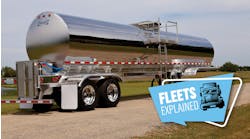The leaders of two of the nation’s largest trucking fleets this week told investors they are seeing some tentative signs that the prolonged freight recession might soon come to an end.
But as quickly as the executives of Knight-Swift Transportation Holdings Inc. and Old Dominion Freight Line Inc.—Nos. 3 and 10 on the 2024 FleetOwner 500 list of top for-hire carriers—voiced those upbeat sentiments on their earnings conference calls, they followed them up with notes of continued caution. Old Dominion President and CEO Marty Freeman even resorted to a Taylor Swift reference, citing her song, “Is It Over Now?” while his Knight-Swift counterpart Adam Miller said there’s “more progress to be made on the cost side” before many carriers can feel truly better about the outlook.
So, no predictions about a market turn on this quarter’s calls. Instead, Old Dominion CFO Adam Satterfield said his team sees the freight demand environment as needing “a little bit more improvement” to get to a long-awaited inflection point.
“There have been some green shoots,” Satterfield said. “You can read through and see some potential opportunity for perhaps later this year. We’re definitely in place. We feel like all the pieces are there.”
Satterfield and Freeman pointed to a decent year-to-date trend of rising volumes and shipment weights, although they haven’t been as strong as historical trends, as well as some national-account wins. Freeman said Old Dominion is operating at a good “base level of operations”—all the while acknowledging that tons per day slipped 3% in the first quarter from early 2023—that sets it up well to benefit from the upturn when it comes.
Miller, who took over at Knight-Swift from Dave Jackson early this year, pointed to an uptick in demand around the Easter holiday as a sign that some end markets have found a bottom.
“Some of that volume has come back. Now, it hasn’t led to premium pricing but it has led to additional volume,” Miller said. “I think the read-through there is that there’s not as much slack in the supply chain as there once was. We’re getting closer to a balance of supply and demand.”
See also: Knight-Swift slashes profits outlook
Still, unlike Freeman and Satterfield—who voiced their confidence in Old Dominion’s ongoing investments that include the addition of 500 employees since September—Miller is very focused on cutting more costs from Knight-Swift’s operations. He and his team aren’t counting on a big summer lift in rates and are instead trimming their fleet of trucks, trailers, and intermodal containers.
“The plan can’t be that the market is going to solve our problems,” Miller said. “We have to control what we can control, and cost is going to be the biggest focus for us. That's what’s going to drive, I believe, the improvement here into the later part of this year. And if we get the market’s help, then great, we’ll take it.”
During the first three months of the year, Knight-Swift posted a net loss of $2.6 million on revenues of $1.82 billion. Adjusted for a loss of nearly $20 million from the company’s now-discontinued third-party insurance business, profits fell to $19.8 million from $118 million in the prior-year period as the company’s truckload, logistics, and intermodal businesses slipped. Old Dominion, meanwhile, earned $292 million on revenues of $1.46 billion, numbers that were both up slightly from the first three months of last year.
Those numbers and the commentary from executives led to both companies’ stocks falling about 10% on April 24 but, commenting about Old Dominion and some competitors’ efforts to emulate its strategy, Stifel analyst Bruce Chan wrote that an upturn will reward investors looking beyond a short-term pop.
“Our view is that LTL growth is not a zero-sum game, especially with recovering manufacturing, return to just-in-time inventory strategy, the return of freight that fled to [truckload] and increased nearshoring,” Chan wrote.




